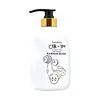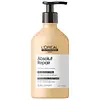What's inside
What's inside
 Key Ingredients
Key Ingredients

 Benefits
Benefits

 Concerns
Concerns

 Ingredients Side-by-side
Ingredients Side-by-side

Water
Skin ConditioningCetearyl Alcohol
EmollientBehentrimonium Chloride
PreservativeAmodimethicone
Cetrimonium Chloride
AntimicrobialGlycerin
HumectantIsopropyl Alcohol
SolventSodium Benzoate
MaskingTrideceth-12
EmulsifyingParfum
MaskingCitric Acid
BufferingPanthenol
Skin ConditioningCeramide NP
Skin ConditioningArgania Spinosa Kernel Oil
EmollientMacadamia Integrifolia Seed Oil
Skin ConditioningHelianthus Annuus Seed Oil
EmollientHydrolyzed Collagen
EmollientGelatin
Hydrolyzed Keratin
HumectantAvena Sativa Protein Extract
Skin ConditioningButylene Glycol
HumectantHydrolyzed Corn Protein
Skin ConditioningHydrolyzed Soy Protein
HumectantHydrolyzed Wheat Protein
Skin Conditioning1,2-Hexanediol
Skin ConditioningChenopodium Quinoa Seed Extract
Skin ConditioningSalvia Hispanica Seed Extract
EmollientLinum Usitatissimum Seed Extract
PerfumingLens Esculenta Seed Extract
Skin ProtectingHelianthus Annuus Seed Extract
Skin ConditioningWater, Cetearyl Alcohol, Behentrimonium Chloride, Amodimethicone, Cetrimonium Chloride, Glycerin, Isopropyl Alcohol, Sodium Benzoate, Trideceth-12, Parfum, Citric Acid, Panthenol, Ceramide NP, Argania Spinosa Kernel Oil, Macadamia Integrifolia Seed Oil, Helianthus Annuus Seed Oil, Hydrolyzed Collagen, Gelatin, Hydrolyzed Keratin, Avena Sativa Protein Extract, Butylene Glycol, Hydrolyzed Corn Protein, Hydrolyzed Soy Protein, Hydrolyzed Wheat Protein, 1,2-Hexanediol, Chenopodium Quinoa Seed Extract, Salvia Hispanica Seed Extract, Linum Usitatissimum Seed Extract, Lens Esculenta Seed Extract, Helianthus Annuus Seed Extract
Water
Skin ConditioningCetearyl Alcohol
EmollientDicetyldimonium Chloride
EmulsifyingCetrimonium Chloride
AntimicrobialDimethicone
EmollientCetyl Esters
EmollientSodium Benzoate
MaskingIsopropyl Alcohol
SolventAmodimethicone
Linalool
PerfumingTrideceth-10
CleansingTartaric Acid
BufferingHexyl Cinnamal
PerfumingChlorhexidine Digluconate
AntimicrobialLimonene
PerfumingPEG-100 Stearate
Phenoxyethanol
PreservativeSteareth-6
EmulsifyingTrideceth-3
EmulsifyingChenopodium Quinoa Seed Extract
Skin ConditioningCI 19140
Cosmetic ColorantAcetic Acid
BufferingHydroxypropyltrimonium Hydrolyzed Wheat Protein
Skin ConditioningTrisodium Hedta
CI 17200
Cosmetic ColorantParfum
MaskingWater, Cetearyl Alcohol, Dicetyldimonium Chloride, Cetrimonium Chloride, Dimethicone, Cetyl Esters, Sodium Benzoate, Isopropyl Alcohol, Amodimethicone, Linalool, Trideceth-10, Tartaric Acid, Hexyl Cinnamal, Chlorhexidine Digluconate, Limonene, PEG-100 Stearate, Phenoxyethanol, Steareth-6, Trideceth-3, Chenopodium Quinoa Seed Extract, CI 19140, Acetic Acid, Hydroxypropyltrimonium Hydrolyzed Wheat Protein, Trisodium Hedta, CI 17200, Parfum
 Reviews
Reviews

Ingredients Explained
These ingredients are found in both products.
Ingredients higher up in an ingredient list are typically present in a larger amount.
This water-soluble silicone is used for its hydrating and softening properties. It is used to add a silky feel to skincare products and has great benefits for haircare.
In haircare, this ingredient:
- Adds shine
- Protects color
- Offers thermal protection
- Boosts hair strength
- Does not build up as easily
Cetearyl alcohol is a mixture of two fatty alcohols: cetyl alcohol and stearyl alcohol. It is mainly used as an emulsifier. Emulsifiers help prevent the separation of oils and products. Due to its composition, it can also be used to thicken a product or help create foam.
Cetearyl alcohol is an emollient. Emollients help soothe and hydrate the skin by trapping moisture.
Studies show Cetearyl alcohol is non-toxic and non-irritating. The FDA allows products labeled "alcohol-free" to have fatty alcohols.
This ingredient is usually derived from plant oils such as palm, vegetable, or coconut oils. There is debate on whether this ingredient will cause acne.
Due to the fatty acid base, this ingredient may not be Malassezia folliculitis safe.
Learn more about Cetearyl AlcoholThis ingredient is a preservative, antimicrobial, and emulsifier. It is often used in cosmetics for its ability to cleanse, condition, and reduce static.
Cetrimonium chloride is a quaternary ammonium salt, meaning it has a water-soluble structure.
We don't have a description for Chenopodium Quinoa Seed Extract yet.
Isopropyl Alcohol is more commonly known as rubbing alcohol. It is most commonly used as a solvent, meaning it helps other ingredients dissolve.
This ingredient is an astringent alcohol. Astringent alcohols may also irritate skin as they high amounts may strip away your skin's natural oils.
Other types of astringent alcohols include:
According to the National Rosacea Society based in the US, you should be mindful of products with these alcohols in the top half of ingredients.
Any type of sanitizing product will have high amounts of alcohol to help kill bacteria and viruses.
Learn more about Isopropyl AlcoholParfum is a catch-all term for an ingredient or more that is used to give a scent to products.
Also called "fragrance", this ingredient can be a blend of hundreds of chemicals or plant oils. This means every product with "fragrance" or "parfum" in the ingredients list is a different mixture.
For instance, Habanolide is a proprietary trade name for a specific aroma chemical. When used as a fragrance ingredient in cosmetics, most aroma chemicals fall under the broad labeling category of “FRAGRANCE” or “PARFUM” according to EU and US regulations.
The term 'parfum' or 'fragrance' is not regulated in many countries. In many cases, it is up to the brand to define this term.
For instance, many brands choose to label themselves as "fragrance-free" because they are not using synthetic fragrances. However, their products may still contain ingredients such as essential oils that are considered a fragrance by INCI standards.
One example is Calendula flower extract. Calendula is an essential oil that still imparts a scent or 'fragrance'.
Depending on the blend, the ingredients in the mixture can cause allergies and sensitivities on the skin. Some ingredients that are known EU allergens include linalool and citronellol.
Parfum can also be used to mask or cover an unpleasant scent.
The bottom line is: not all fragrances/parfum/ingredients are created equally. If you are worried about fragrances, we recommend taking a closer look at an ingredient. And of course, we always recommend speaking with a professional.
Learn more about ParfumSodium Benzoate is a preservative. It's used in both cosmetic and food products to inhibit the growth of mold and bacteria. It is typically produced synthetically.
Both the US FDA and EU Health Committee have approved the use of sodium benzoate. In the US, levels of 0.1% (of the total product) are allowed.
Sodium benzoate works as a preservative by inhibiting the growth of bacteria inside of cells. It prevents the cell from fermenting a type of sugar using an enzyme called phosphofructokinase.
It is the salt of benzoic acid. Foods containing sodium benzoate include soda, salad dressings, condiments, fruit juices, wines, and snack foods.
Studies for using ascorbic acid and sodium benzoate in cosmetics are lacking, especially in skincare routines with multiple steps.
We always recommend speaking with a professional, such as a dermatologist, if you have any concerns.
Learn more about Sodium BenzoateWater. It's the most common cosmetic ingredient of all. You'll usually see it at the top of ingredient lists, meaning that it makes up the largest part of the product.
So why is it so popular? Water most often acts as a solvent - this means that it helps dissolve other ingredients into the formulation.
You'll also recognize water as that liquid we all need to stay alive. If you see this, drink a glass of water. Stay hydrated!
Learn more about Water